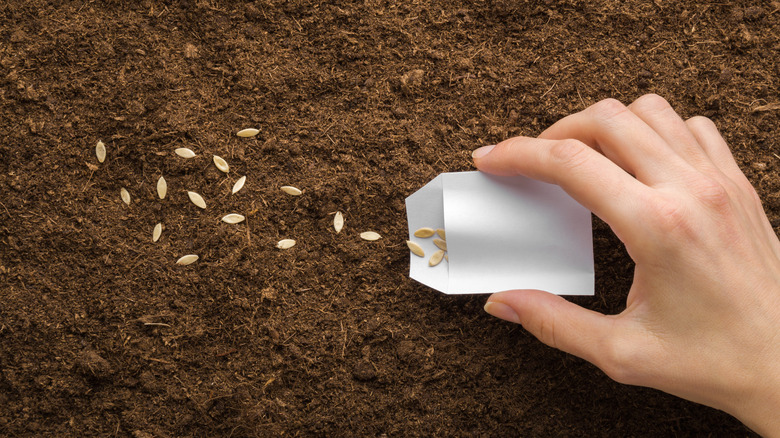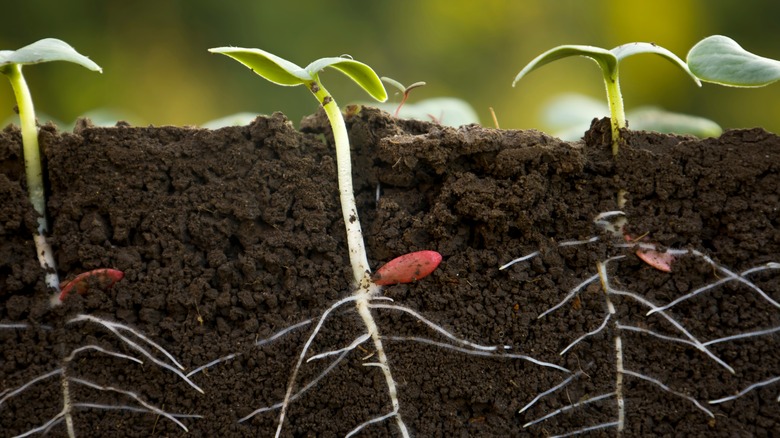Try The Snail Rolling Technique To Give You Cucumber Seeds A Head Start
The next time you're in the process of planting a new cucumber crop, drop the bulky seed starting trays and consider picking up some polyethylene foam instead. The thermoplastic foam material is commonly used for insulation, foam tapes, and padding for furniture. However, a new use for the foam, called seed snail rolling, took the social media world by storm after gardening enthusiast Instagram user @faridasober shared the method online. The method gets its name from the way a bird's-eye-view of the rolled up foam material resembles the coils on a snail's shell. With the seed snail rolling technique, foam is cut into strips, layered with soil, rolled together, and secured with tape. Seeds are then planted at the top of the foam layer until they are ready for transplanting. For cucumber plants, in particular, this technique can set them up for healthy growth.
While this method is unconventional, the benefits are worth giving it a shot. The technique helps train your cucumber seedlings' roots, saves you space, and is sustainable depending on which materials you choose to craft your snail shell layer. Additionally, it's easy to assemble with a few materials, many of which you may already have at home.
Assembling a seed snail roll for your cucumber seeds
Polyethylene foam is a popular choice for the snail roll, but you can use eco-friendly options like burlap or cardboard. You'll also need scissors, seed starting mix or compost, cucumber seeds, and tape. First, cut your material into 4 to 6 inch wide strips. Then, place your starting mix or compost on top of the material. Dampen your soil with water to keep it in place and take one end and roll it up like you would a sleeping bag. Secure the roll shut with strips of cello tape.
Now, you can plant your cucumber seeds. Create a flat surface within the top of the snail coil and sow the seeds approximately 1.5 inches deep. Cover them with a fine layer of soil and gently water them in. Place your seed snail roll in the sun, since cucumber plants require plenty of light. Seeds will germinate in five to 10 days. Transplant them when they have two to three true leaves (the best time of year to plant them is early spring). To transplant your cucumber seedlings, remove the tape from your snail roll, unravel the roll, and gently separate the seedlings. You may find that some of the roots enmeshed with one another, but because the roots grew vertically rather than in a clump, the transplants are easy to separate with minimal root breakage.
The benefits of the seed snail rolling method
You'll be happy to know that the seed snail rolling method doesn't skimp on benefits. One advantage to this technique is that it's a space saver. Because the seeds are wrapped in a compact roll rather than a bulky tray, you can house these snail rolls in a smaller area. Thus, the seed snail rolling method is great way to start seeds indoors when you have limited space. The second benefit is that your cucumbers will experience stronger root systems. This is because the roots are trained to grow vertically when grown with the seed snail rolling technique, and won't tangle in a ball like those growing in an enclosed tray cell would. Having the roots grow vertically helps reduce transplant shock when repotting because there's less of a chance of them tearing when it's time to plant the seedlings. Cucumber roots are shallow, fragile, and require extra care when transplanting.
Additionally, the vertical growth allows for a long taproot to form. This helps your cucumber plants absorb water deep within the soil during times of drought or under watering. Lastly, this method is sustainable in that you can repurpose a number of materials to make the snail shell layer. Burlap, cardboard, and linens for example, make for eco-friendly alternatives to the aforementioned polyethylene foam.

